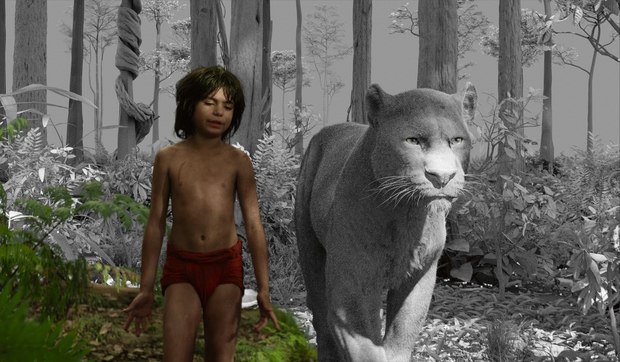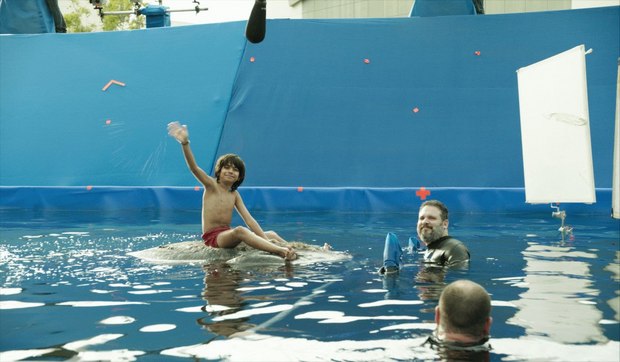Heading into Awards Season, the director of Disney’s 2016 photoreal live-action/CG hybrid action-adventure hit reflects on his initial skepticism and concerns adapting an animated feature film classic.
Disney and Jon Favreau’s live-action/CG hybrid adaptation of Walt Disney’s 1967 animated feature film classic, The Jungle Book, which hit theatres last April 15, was both a marvel of technology-driven cinematic storytelling and a box office smash. Made for a reported $175 million and shot with a single actor in a downtown Los Angeles warehouse, the film racked up almost $1 billion in global ticket sales.
But it was only with the more recent technological advances developed on film’s like Avatar and Life of Pi that Disney’s vision for a stylized photorealistic version of the extraordinary 2D hand drawn ’67 film became possible. It took some time for Walt Disney Studios chairman Alan Horn to convince Favreau to take the helm of an almost completely CG film. AWN’s Spencer Fawcett recently spoke to the acclaimed director about his initial concerns as well as skepticism about CGI and tackling fan-favorites for theatrical adaptation.
Spencer Fawcett: What drew you to this project? Did Disney come to you to adapt or did you pitch the idea of adapting the 1967 animated film to them?
Jon Favreau: They came to me to adapt. It was not a “no-brainer” for me. I really dug the original ’67 film that I grew up with and there were certainly a lot of ways to go wrong with this project. I have enjoyed watching Disney animated films transition to live-action. Cinderella was coming out at the time we were filming and I thought that using technology today to recreate some of the images from the animated film was cool. I had a good time working on the Iron-Man movies. They were a lot of fun. But I had been doing a lot of that already. After seeing Life of Pi, when Alan Horn [chairman of Walt Disney Studios] talked to me about his passion for the Kipling stories he grew up with, I started getting excited that something similar could be done with a story that was very human, emotional and naturalistic.
SF: By turning animals into much more human-like characters than had previously been done in other films.
JF: That’s part of it too. I was very skeptical of CGI -- my early stuff had a lot of practical effects. Then with Iron-Man, I kinda came around a bit. Seeing movies like Avatar and Gravity made me think, “Maybe we’re at that point.” If you design it well and have the right people working with you, there are ways to make it convincing. We were definitely scared of putting together this big puzzle much of the time, but then we started seeing it work out.
SF: Were there any iconic images or scenes from the original film that you hoped to recreate?
JF: Yeah, there were a few that we grabbed onto that were iconic. Before I watched the ’67 film, I made a list of, “What are the moments and images I remember from the animated movie?” Some of those were “Bare Necessities” with Baloo and Mowgli going down the river, Ka wrapping Mowgli up and the elephants walking. I just wanted to get to the images that cut through the years. Then I watched the ’67 movie and it’s nothing like I remembered. I wanted to honor that film, the Kipling story, as well as bring it all to live-action, [but in a way] which would be tonally different from the children’s musical.
There were a lot of spinning plates [during the making of this film]. Plus, we had to make sure that the animals looked naturalistic. So we looked at Bambi a lot for inspiration. That’s when Walt was worried about the transition from the cartoony animals of Snow White to the naturalism of Bambi. I found myself wrestling with the same things as Walt, who used cutting-edge technology for his day, but with a different set of tools and technologies.
SF: I watched the featurette [shown above] and saw that you, VFX supervisor and 2nd unit director Rob Legato, producer Brigham Taylor used the book from the Disney Vault for the opening title sequence as the framing device for the film. Can you talk about that decision?
JF: It took over a year to get permission from Disney to use that. Usually, if you want to go to the archives, there are people with white gloves who will thumb through things for you. But to actually film it on our set was important. I wanted to start off with that because that’s how the ’67 film opened, but never closed. The opening starts off with the Disney logo, which was practically done with painted cells -- then we used the multi-plane technique. Again, we looked to Bambi for inspiration, transitioning to the waterfall and live-action CG looking environment. John Debney came in and re-scored “When You Wish Upon a Star” using very traditional orchestration as a nod to the past.
SF: How was it working with Disney during the production? The Jungle Book is the tip of the spear for more live-action Disney films. Were they protective in saying that you could or couldn’t do something…for example, not doing King Louie as a traditional orangutan? : Honestly, I was more concerned with the “Disney” of it all. What I mean by that is the ’67 film belongs to the audience in a way. I learned with Iron-Man and starting the MCU [Marvel Cinematic Universe] that you must be acutely aware whenever you take pre-established material where there’s a relationship with the fans. Now, with Avatar, you can start from scratch and do what you want because there’s no precedent yet. When I cast for Iron-Man, I knew that you better cast someone who can deliver on the 40-years of comics and honor the spirit of who Tony Stark is. With Disney, you didn’t have the same level of interaction but I knew that when I went to D23 and brought footage, I still had to honor that ’67 film that so many people held dear.
JF: They were very open, as far as corporate entities go, and knew that there was an audience for the film. I was more tuned into the conversation and zeitgeist of it all. It’s different when you’re running a company, as opposed to me, an audience member who grew up with this stuff. So I knew to include what people connected with -- if you don’t have “Bare Necessities,” then it’s not The Jungle Book. It [that song] may not have been in the Kipling stories but it was in the animated film and so we did the 2016 film in such a way that connects to the original.
SF: I know you’re working on the live-action The Lion King film, but can you give us a teaser for what you’re planning to do with The Jungle Book 2?
JF: It’s difficult using the same techniques available to us that we used for the first film. Plus we used a lot of the songs. Part of it [the challenge] is that you’re continuing what was explored in the first film -- how do you continue to honor the source material in the same way so that it doesn’t feel like you’re arbitrarily telling a new story? What characters weren’t explored in the first one? What songs weren’t in the first one? We’re really looking to find ways to remain connected with the ’67 film even though we covered a lot of ground in our first film. That’s the part we’ve prioritized the most.


















